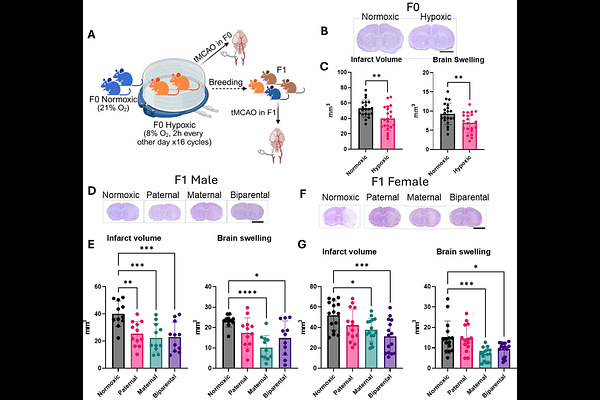Intergenerational Conditioning via Intermittent Parental Hypoxia Confers Stroke Resilience in Offspring

Intergenerational Conditioning via Intermittent Parental Hypoxia Confers Stroke Resilience in Offspring
Caglayan, A. B.; Beker, M. C.; Felix-Ilemhenbhio, F.; Altunay, S.; Yelkenci, H. E.; Caglayan, A.; Dogan, E.; Ates, N.; Bae, O.-N.; Burrows, D. J.; Ali, A.; De Felice, M.; Kilic, E.; Majid, A.
AbstractBackground and Aims: Intergenerational disease transmission, where parental exposures or experiences influence disease susceptibility in offspring, may represent a crucial layer of stroke risk that extends beyond genetics alone. Environmental conditioning, such as intermittent sub-lethal hypoxia, can induce adaptive protective stress responses in the brain. However, whether such parental conditioning enhances offspring resilience to cerebral ischaemia remains unclear. This study investigates whether intermittent hypoxia in parents acts as an intergenerational conditioning stimulus, conferring resilience to ischaemic stroke in offspring, and explores associated molecular mechanisms. Methods: Male and female Balb/C mice (F0) were exposed to intermittent hypoxia (8% O2, 2 hours every other day, 16 cycles) prior to mating. To confirm that intermittent hypoxia induced neuroprotection in the parental generation, a separate cohort of F0 mice underwent transient middle cerebral artery occlusion (tMCAO). Offspring (F1) were generated from hypoxia-exposed F0 breeders and divided into four groups: biparental hypoxia, paternal hypoxia, maternal hypoxia, and normoxic controls. Adult F1 offspring also underwent tMCAO to model ischaemic stroke. Infarct volume and brain swelling were assessed 48 hours post-ischaemia. In a subgroup of F1 offspring, tandem mass tag (TMT)-based proteomic analysis of injured brain tissue was performed post-stroke to identify molecular pathways associated with neuroprotection. Results: Parental intermittent hypoxia significantly reduced infarct size and swelling in F0 mice. These protective effects were inherited by F1 offspring, with biparental exposure producing the greatest reduction in infarct volume, followed by maternal-only and paternal-only groups, and exhibiting sex-specific differences. Proteomic profiling revealed distinct treatment and lineage clusters. Key pathways implicated in offspring neuroprotection included metabolic regulation, immune signalling, cytoskeletal organisation, and cell survival, notably involving PI3K-Akt and EGFR pathways. Conclusions: Intermittent hypoxia in parents acts as an intergenerational conditioning stimulus, conferring offspring resilience to ischaemic stroke. This neuroprotective phenotype is supported by coordinated molecular adaptations in key pathways involved in survival and stress response. These findings highlight the potential for parental environmental conditioning to shape stroke outcomes in offspring, opening new avenues for therapeutic exploration.